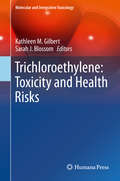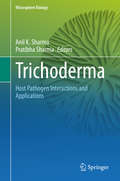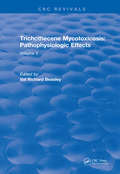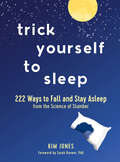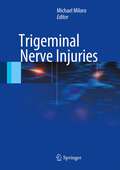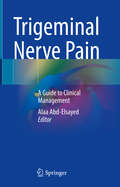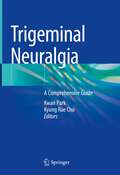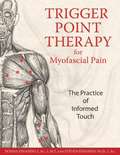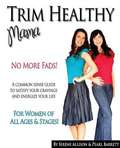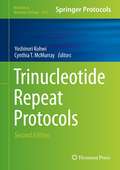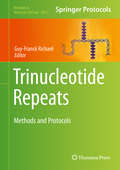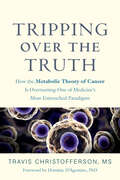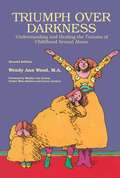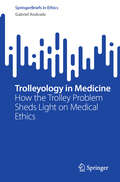- Table View
- List View
Trichloroethylene: Toxicity and Health Risks
by Kathleen M. Gilbert Sarah J. BlossomA comprehensive overview of the effects of trichloroethylene toxicity caused by real-life exposure levels highlighting how exposure to trichloroethylene may contribute to the etiology of several idiopathic human diseases. Discussion will focus on different kinds of modeling and how they may be used to predict functional consequences and to dissect the contribution of different mechanistic pathways, including potential mechanisms of action for trichloroethylene toxicity in different organ systems. It will explore the role of epigenetic alterations in trichloroethylene toxicity, this provides important mechanistic information and may also provide the basis for intervention therapy. Chapters will also explain how the risks from trichloroethylene exposure may be greater in certain populations based on genetic predisposition, age of exposure and co-exposure to other chemicals With contributions from international experts in the field, Trichloroethylene: Toxicity and Health Risks is an essential resource for researchers and clinicians in toxicology, immunology, medicine and public health as well as industry and government regulatory scientists involved in safety and health protection and epidemiologists, highlighting the need for interdisciplinary cooperation in solving issues of environmental toxicity.
Trichoderma: Host Pathogen Interactions and Applications (Rhizosphere Biology)
by Anil K. Sharma Pratibha SharmaThis book compiles the latest research in the area of Trichoderma Rhizosphere Biology. It covers topics such as microbial interaction, crosstalk between plants and microbes, interactions with abiotic and biotic factors, and advances in biocontrol agents, biofertilizers and biostimulants. The respective chapters describe innovative ways of adapting fungal communities to improve their survival in highly dynamic environments and agroecosystems. In closing, the book discusses the use of Trichoderma as a bio-growth enhancer and biostimulant for organic agriculture.
Trichothecene Mycotoxicosis Pathophysiologic Effects: Volume I (CRC Press Revivals)
by Val Richard BeasleyThere are instances of unresolved differences of opinion , as in the case of underlying biochemical mechanisms of action. It has been particularly challenging to interpret the diversity of effects induced by several trichothecenes when studied in various cells, tissues, and concentrations, and at dissimilar intervals. In the hope of shortening the time needed to overcome these difficulties, the authors have sought to discuss a range of observations delineating both areas of agreement and aspects remaining to be clarified. The final chapter of the volumes is comprised of an effort to integrate the various observations detailed throughout the book. With the continued efforts of not only the many dedicated scientists who served as contributors to these volumes, but from the many other authors cited herein and those to follow, out understanding of these interesting compounds will continue to expand. We have already learned enough to greatly reduce the adverse effects of the trichothecene mycotoxins on humans and other animals.
Trichothecene Mycotoxicosis Pathophysiologic Effects: Volume II (CRC Press Revivals)
by Val Richard BeasleyThere are instances of unresolved differences of opinion , as in the case of underlying biochemical mechanisms of action. It has been particularly challenging to interpret the diversity of effects induced by several trichothecenes when studied in various cells, tissues, and concentrations, and at dissimilar intervals. In the hope of shortening the time needed to overcome these difficulties, the authors have sought to discuss a range of observations delineating both areas of agreement and aspects remaining to be clarified. The final chapter of the volumes is comprised of an effort to integrate the various observations detailed throughout the book. With the continued efforts of not only the many dedicated scientists who served as contributors to these volumes, but from the many other authors cited herein and those to follow, out understanding of these interesting compounds will continue to expand. We have already learned enough to greatly reduce the adverse effects of the trichothecene mycotoxins on humans and other animals.
Trick Yourself to Sleep: 222 Ways To Fall And Stay Asleep From The Science Of Slumber
by Kim Jones222 Ways to a Better Night and Brighter Morning Poor sleep can wreak havoc on your waking life, leaving you grumpy and unwell. But when you’re staring at the ceiling, counting sheep, worried that sleep may never come . . . what can you do? Well, Trick Yourself to Sleep—with 222 simple strategies and creative tips, all scientifically backed: Cover up clocks (stop stressing over every restless minute) Eat two kiwis (their folates and antioxidants aid sleep) Stick out your tongue (this releases tension in the jaw) Try a weighted blanket (it’s like giving your nervous system a hug) Make a list (and then set those to-dos aside until tomorrow)! This must-have guide for even the occasional insomniac will help you fall asleep, stay asleep, and wake up your best self.
Trick or Treatment: The Undeniable Facts about Alternative Medicine
by Simon Singh Edzard ErnstThe truth about the potions, lotions, pills and needles, pummelling and energizing that lie beyond the realms of conventional medicine. Whether you are an ardent believer in alternative medicine, a skeptic, or are simply baffled by the range of services and opinions, this guide lays to rest doubts and contradictions with authority, integrity, and clarity. In this groundbreaking analysis, over thirty of the most popular treatments--acupuncture, homeopathy, aromatherapy, reflexology, chiropractic, and herbal medicines--are examined for their benefits and potential dangers. Questions answered include: What works and what doesn't? What are the secrets, and what are the lies? Who can you trust, and who is ripping you off? Can science decide what is best, or do the old wives' tales really tap into ancient, superior wisdom?In their scrutiny of alternative and complementary cures, authors Simon Singh and Edzard Ernst also strive to reassert the primacy of the scientific method as a means for determining public health practice and policy.
Tricks and Traps in MRI of the Pituitary Region
by Jean-François BonnevilleThis book describes the challenges occurring during a pituitary examination and provides key pieces for diagnosis. It takes into account unusual issues encountered when reading a pituitary MRI. Each chapter covers the common traps faced during the interpretation of pituitary MRI, for instance, in the presence of pituitary adenomas, Rathke cleft cysts, craniopharyngiomas, and many other pathological conditions, before offering solutions to come to the correct diagnosis. This concise practical guide offers helpful information for radiologists and neurosurgeons, but the book will also interest endocrinologists and internists.
Tricuspid Valve Disease: A Comprehensive Guide to Evaluation and Management (Contemporary Cardiology)
by Hansie Mathelier Scott M. Lilly Satya ShreenivasThis book provides a comprehensive overview of the physiology, pathophysiology, diagnosis, medical and surgical management, and future therapies for tricuspid valve disease. It is divided into two sections. The first section covers the basics of the tricuspid valve, including anatomy, epidemiology, and clinical diagnosis with individual chapters focused on hemodynamics, echocardiography, MRI, and CT assessment. The second section examines current treatments for tricuspid valve disease including both surgical and medical management. It discusses special clinical scenarios of tricuspid valve pathology such as tricuspid regurgitation in patients with ICD and pacemaker implants and the role of tricuspid valve disease in patients with heart failure and LVAD therapy. Tricuspid Valve Disease: A Comprehensive Guide to Evaluation and Management is an essential resource for general cardiologists, interventional cardiologists, cardiac surgeons, and innovators in the field of structural heart disease.
Trigeminal Nerve Injuries
by Michael MiloroTrigeminal nerve injuries present complex clinical challenges and can be very distressing for patients, resulting in abnormal sensations of the oro-facial region, yet surgeons may lack the knowledge required for optimal patient management based upon the specific nerve injury. This textbook is the first to be devoted to the diagnosis and management of trigeminal nerve injuries. A wide range of topics are covered, including historical perspectives, demographics, etiology, anatomy and physiology, pathophysiology, clinical neurosensory testing, nonsurgical management, and surgical management and principles of microneurosurgery, specifically involving the inferior alveolar and lingual nerves. Algorithms and a glossary are provided that will assist in the clinical management of these complex scenarios. The authors include surgeons with considerable experience and expertise in the field who have previously published on the subject. This book will serve as an ideal clinical reference for surgeons with patients who sustain trigeminal nerve injuries.
Trigeminal Nerve Pain: A Guide to Clinical Management
by Alaa Abd-ElsayedThis book provides an overview of the history, anatomy, epidemiology, diagnosis (HPI, PE, Imaging), non-pharmacological management and medication management of trigeminal nerve pain. Nerve blocks for the trigeminal nerve and branches, Radiofrequency ablation, chemodenervation, cryotherapy, botox injections, neuromodulation infusion therapy, balloon compression gamma knife therapy, decompression surgery, peripheral neurectomy and the psychological impact are also examined with an algorithm for management recommendations included in the final chapter. Trigeminal Nerve Pain - A Guide to Clinical Management comprehensively covers how to manage patients with this often debilitating pain and is of use to trainees and practising internists, hospitalists, surgeons and anaesthesiologists seeking to increase their understanding of this complex condition.
Trigeminal Neuralgia: A Comprehensive Guide
by Kwan Park Kyung Rae ChoThis book is focused on surgical treatment in trigeminal neuralgia (TN). Though microvascular decompression (MVD) is definite treatment for medically uncontrollable TN, manual focused on the surgical treatments are rare. This book includes overall view of TN, from diagnosis to treatment, more focused on technical pearls on MVD for neurosurgeons. Essential information of anatomy and pathophysiology are provided. Main topics would be indications, surgical considerations, electrophysiological monitoring during MVD surgery and outcomes of surgery. Furthermore, other non-surgical peripheral block techniques, radiosurgery and recent updated techniques will be discussed. The main target of this book will be neurosurgeons, neurosurgical trainees and also other physicians who’s in charge of patients suffering from neuralgic pains.
Trigeminal Neuralgias: A Neurosurgical Illustrated Guide
by Marc Sindou Andrei BrinzeuThis book is focused on trigeminal neuralgias and their management, a field in which, during the two past decades, there were numerous advances in comprehension of mechanisms of the disease and diagnosis with imaging, as well as in medical therapies and in surgical treatment. The authors are well-known specialists for this treatment and summarize their long experience in this comprehensive and practical book. They are experts not only on the surgical treatment of trigeminal neuralgia with the micro-vascular decompression procedure but also with the lesioning procedures. In this pictorial guide, readers can find the pathways for diagnosis, and practical guidelines to help decision-making among the most appropriate treatments, tailored on to every patient’s need. Neurologists, neurosurgeons, and dentists, but also ENT specialists, ophthalmologists, and maxillofacial specialists, would find an invaluable support in this book devoted to a rather frequent problem to deal with.
Trigger Point Therapy for Myofascial Pain: The Practice of Informed Touch
by Donna Finando Steven FinandoA clinical reference manual for the evaluation and treatment of muscle pain. Myofascial pain syndromes are among the fastest growing problems that physicians, osteopaths, acupuncturists, and physical, occupational, and massage therapists encounter in their patients. In Trigger Point Therapy for Myofascial Pain Donna and Steven Finando have organized vast amounts of information on treating myofascial pain into an accessible "user's manual" for healthcare practitioners. They examine a wide range of pain patterns and present evaluation and palpation techniques for reducing trigger points--and thereby alleviating pain--in the most clinically significant musculature of the body. This comprehensive yet easy-to-use reference guide to treatment of muscle pain begins with chapters on the concept of Qi and its relationship to myology, specific trigger point location and activation, and palpatory skill-building techniques. Subsequent sections provide detailed information on each muscle to teach clinicians to locate quickly and accurately individual points of pain and compensation. A visual index allows easy identification of the muscles that may be involved. Trigger Point Therapy for Myofascial Pain provides necessary and invaluable information for sufferers and any professional involved with myofascial disorders.
Triggered: A Memoir of Obsessive-Compulsive Disorder
by Fletcher Wortmann***AS FEATURED ON NPR'S TALK OF THE NATION***Imagine the worst thing in the world. Picture it. Construct it, carefully and deliberately in your mind. Be careful not to omit anything. Imagine it happening to you, to the people you love. Imagine the worst thing in the world. Now try not to think about it. This is what it is like for Fletcher Wortmann. In his brilliant memoir, the author takes us on an intimate journey across the psychological landscape of OCD, known as the "doubting disorder," as populated by God, girls, and apocalyptic nightmares. Wortmann unflinchingly reveals the elaborate series of psychological rituals he constructs as "preventative measures" to ward off the end times, as well as his learning to cope with intrusive thoughts through Clockwork Orange-like "trigger" therapy.But even more than this, the author emerges as a preternatural talent as he unfolds a kaleidoscope of culture high and low ranging from his obsessions with David Bowie, X-Men, and Pokemon, to an eclectic education shaped by Shakespeare, Kierkegaard, Catholic mysticism, Christian comic books, and the collegiate dating scene at the "People's Republic of Swarthmore." Triggered is a pitch-perfect memoir; a touching, triumphantly funny, compulsively readable, and ultimately uplifting coming-of-age tale for Generation Anxiety.Fletcher Wortmann on OCD and sex:"If a girl accepts an invitation to help count the tiles on your bedroom ceiling, then she will probably be disappointed when she realizes you were speaking literally."…on OCD and religion:"I have found Catholicism and obsessive compulsive disorder to be deeply sympathetic to one another. One is a repressive construct founded in existential terror, barely restrained by complex, arbitrary ritual behaviors; the other is an anxiety disorder."…on OCD humor:"By the sink, I noticed a perfunctory sign warning readers to wash their hands. It was scrawled with graffiti: NO YOU CAN'T GERMS ARE UNPREVENTABLE AND INESCAPABLE."…on the seductiveness of OCD:"Every so often, everything will work, and you will somehow convince yourself that you are safe, and the disorder will claim credit. I had struck a bargain with the OCD. The transaction was complete. In that moment I became subservient to it."
Trim Healthy Mama: No More Fads
by Pearl Barrett Serene AllisonTrim Healthy Mama No More Fads! A Common Sense Guide To Satisfy Your Cravings And Energize Your Life. For Women Of All Ages And Stages! Over 250 Recipes, Proven Ways to Lose Weight, How to Balance your Hormones, How to Re-fire your Metabolism, Make your Skin Glow, Ignite Marriage Intimacy, Simple but Effective Exercise Plan. (for Pregnant Mothers too!) Answers for Postmenopausal Women.
Trinucleotide Repeat Protocols
by Yoshinori Kohwi Cynthia T. McmurrayTwo decades have passed since trinucleotide repeat expansion was first discovered in genes responsible for certain neurological diseases. Since then, new technologies have developed and innovative concepts have emerged, which may prove useful in devising therapeutic approaches to neurological diseases. Divided into six convenient sections, Trinucleotide Repeat Protocols, Second Edition covers a wide range of topics such as an overview of trinucleotide repeat diseases, synaptic plasticity, embryonic stem (ES) cell-related protocols with a focus on HD, RNA-related protocols, and analysis of epigenetic modification in fragile X syndrome. This edition focuses not only on direct analysis of trinucleotide repeat diseases but also on alternative approaches for the analysis of trinucleotide repeat diseases, with the hope that this will result in a better understanding of the mechanisms and future therapeutic prospects for treatment of these diseases. Written in the successful Methods in Molecular BiologyTM series format, chapters include introductions to their respective topics, lists of the necessary materials and reagents, step-by-step, readily reproducible protocols, and notes on troubleshooting and avoiding known pitfalls. Authoritative and easily accessible, Trinucleotide Repeat Protocols, Second Edition seeks to serve researchers with its thorough methodologies on this expanding field.
Trinucleotide Repeats: Methods and Protocols (Methods in Molecular Biology #2056)
by Guy-Franck RichardThis detailed book contains techniques to explore the unusual properties of the peculiar microsatellites known as trinucleotide repeats. Beginning with technical challenges raised by secondary structure-forming repeats and their propensity to contract and expand over time, the book continues with genetic screens in Saccharomyces cerevisiae, experimental systems to study trinucleotide repeat instability in human cells, dedicated experimental systems in appropriate cell types, as well as gene therapy approaches using the CRISPR-Cas family of endonucleases. Written for the highly successful Methods in Molecular Biology series, chapters include introductions to their respective topics, lists of the necessary materials and reagents, step-by-step, readily reproducible laboratory protocols, and tips on troubleshooting and avoiding known pitfalls. Authoritative and practical, Trinucleotide Repeats: Methods and Protocols serves as a valuable aid to experts and newcomers alike who seek to investigate this fascinating and ever-expanding field of study.
Trip: Psychedelics, Alienation, and Change
by Tao LinPart memoir, part history, part journalistic exposé, Trip is a look at psychedelic drugs, literature, and alienation from one of the twenty-first century's most innovative novelists--The Electric Kool-Aid Acid Test for a new generation. A Vintage Original.While reeling from one of the most creative--but at times self-destructive--outpourings of his life, Tao Lin discovered the strange and exciting work of Terence McKenna. McKenna, the leading advocate of psychedelic drugs since Timothy Leary, became for Lin both an obsession and a revitalizing force. In Trip, Lin's first book-length work of nonfiction, he charts his recovery from pharmaceutical drugs, his surprising and positive change in worldview, and his four-year engagement with some of the hardest questions: Why do we make art? Is the world made of language? What happens when we die? And is the imagination more real than the universe?In exploring these ideas and detailing his experiences with psilocybin, DMT, salvia, and cannabis, Lin takes readers on a trip through nature, his own past, psychedelic culture, and the unknown.
Tripping over the Truth: How the Metabolic Theory of Cancer Is Overturning One of Medicine's Most Entrenched Paradigms
by Travis ChristoffersonA masterful synchronization of history and cutting-edge science shines new light on humanity&’s darkest diagnosis.Over 50,000 copies sold! &“Tripping over the Truth will have profound consequences for how cancer is managed and prevented.&”—Thomas N. Seyfried, author of Cancer as a Metabolic DiseaseIn the wake of the Cancer Genome Atlas project&’s failure to provide a legible roadmap to a cure for cancer, science writer Travis Christofferson illuminates a promising blend of old and new perspectives on the disease. Tripping over the Truth follows the story of cancer&’s proposed metabolic origin from the vaunted halls of the German scientific golden age to modern laboratories around the world. The reader is taken on a journey through time and science that results in an unlikely connecting of the dots with profound therapeutic implications.Transporting us on a rich narrative of humanity&’s struggle to understand the cellular events that conspire to form malignancy, Tripping over the Truth reads like a detective novel, full of twists and cover-ups, blind-alleys and striking moments of discovery by men and women with uncommon vision, grit, and fortitude. Ultimately, Christofferson arrives at a conclusion that challenges everything we thought we knew about the disease, suggesting the reason for the failed war against cancer stems from a flawed paradigm that categorizes cancer as an exclusively genetic disease.For anyone affected by this terrifying disease and the physicians who struggle to treat it, this book provides a fresh and hopeful perspective. It explores the new and exciting non-toxic therapies born from the emerging metabolic theory of cancer. These therapies may one day prove to be a turning point in the struggle against our ancient enemy. We are shown how the metabolic theory redraws the battle map, directing researchers to approach cancer treatment from a different angle, framing it more like a gentle rehabilitation rather than all-out combat. In a sharp departure from the current &“targeted&” revolution occurring in cancer pharmaceuticals, the metabolic therapies highlighted have one striking feature that sets them apart—the potential to treat all types of cancer because they exploit the one weakness that is common to every cancer cell: dysfunctional metabolism.With a foreword by Dr. Dominic D&’Agostino, PhD and contributions from Thomas Seyfried, PhD, author of Cancer as a Metabolic Disease; Miriam Kalamian, EdM, MS, CNS, author of Keto for Cancer; and Beth Zupec Kania, consultant nutritionist of The Charlie Foundation.&“Brilliant, timely, and expertly consolidated . . . It reads like a novel and is easy to comprehend for everyone interested in the new conversation around cancer and cancer care. I recommend it to patients, family, friends, and colleagues and refer back to it often.&”—Dr. Nasha Winters, ND, coauthor of The Metabolic Approach to Cancer
Trippy: The Peril and Promise of Medicinal Psychedelics
by Ernesto LondoñoA riveting look at the tremendous promise and inherent risks of the use of psychedelics in mental health treatment through the lens of a New York Times reporter whose journalistic exploration of this emerging field began with a personal crisis.When he signed up for a psychedelic retreat run by a mysterious Argentine woman deep in Brazil’s rainforest in early 2018, Ernesto Londoño, a veteran New York Times journalist, was so depressed he had come close to jumping off his terrace weeks earlier. His nine-day visit to Spirit Vine Ayahuasca Retreat Center included four nighttime ceremonies during which participants imbibed a vomit-inducing plant-based brew that contained DMT, a powerful mind-altering compound.The ayahuasca trips provided Londoño an instant reprieve from his depression and became the genesis of a personal transformation that anchors this sweeping journalistic exploration of the booming field of medicinal psychedelics. Londoño introduces readers to a dazzling array of psychedelic enthusiasts who are upending our understanding of trauma and healing. They include Indigenous elders who regard psychedelics as portals to the spirit world; religious leaders who use mind-bending substances as sacraments; war veterans suffering from PTSD who credit psychedelics with changing their lives; and clinicians trying to resurrect a promising field of medicine hastily abandoned in the 1970s as the United States declared a War on Drugs.Londoño’s riveting personal narrative pulls the reader through a deeply researched and brilliantly reported account of a game-changing industry on the rise. Trippy is the definitive book on psychedelics and mental health today, and Londoño’s in-depth and nuanced look at this shifting landscape will be pivotal in guiding policymakers and readers as they make sense of the perils, limitations, and promises of turning to psychedelics in the pursuit of healing.
Triumph Over Darkness: Understanding and Healing the Trauma of Childhood Sexual Abuse
by Wendy Ann WoodThis collection of prose and therapeutic insights creates a powerful commentary on incest, rape, abuse, and the recovery process. Women and men share their personal experiences of childhood abuse and walk with the reader along the path toward wellness. They reflect each stage of healing with a clarity that, while often painful, is also hopeful. Addressing various aspects of abuse, including ritualistic abuse, multiple personality disorder, and partnering as well as providing a therapist's insights on the stages of healing, Triumph Over Darkness helps readers to understand recovery as a predictable process and see that healing is possible.
Trocar Surgery for Cataract Surgeons: From Dislocated IOL to Dropped Nucleus
by Ulrich SpandauThis book describes how trocar cannulas can be utilized by cataract surgeons in the treatment of complications of cataract injuries. Cataract is still the first cause of blindness in the world, and as such, complications inevitably occur during and after surgery. Trocar surgery has the potential to revolutionize anterior segment surgery, demonstrated here as an easy-to-use technique for conquering the pars plana region. This book describes the simple technique of trocar surgery utilizing trocar cannulas with clear and precise diagrams and video content, making it easy to learn and implement for cataract surgeons.Trocar Surgery for Cataract Surgeons systematically details how trocar surgery can be used to expand the surgical spectrum for cataract surgeons and provide the basis for novel surgical techniques in the field. The videos of this book are available at the Springer Link website.
Trolleyology in Medicine: How the Trolley Problem Sheds Light on Medical Ethics (SpringerBriefs in Ethics)
by Gabriel AndradeThis book provides an overview of how the intricacies of the Trolley Problem shed light on various aspects of medical ethics. It shows how trolley dilemmas have become useful to ethicists to the extent that they activate intuitions and provide guidance about what the relevant moral principle ought to be in judging specific actions. Issues are covered at length such as euthanasia, where it is important to determine a relevant difference between killing and letting die; and abortion, where it is necessary to establish if harms can be used as a means to an end. While specialists in medical ethics have argued about these topics at length, few have established connections with the complexities of trolley cases. The Trolley Problem has now become a staple of pop culture and yet, outside philosophy, few people understand its implications. Consequently, this book is of interest to those with a general interest in philosophy, students, researchers as well as those in the healthcare industry where many of the difficult moral decisions encountered are better informed by framing them around the intricacies of the Trolley Problem.
Tropane Alkaloids: Pathways, Potential and Biotechnological Applications
by Vikas Srivastava Shakti Mehrotra Sonal MishraThis book covers the current research on the biochemistry and biotechnological applications of plant-based Tropane alkaloids. Tropane alkaloids (TA)belong to the world’s oldest phytomedicines with their valuable ethno-pharmacological applications.The book compiles scientific ideas, perspectives and challenges in the application of TA in the present day. The book also provides case studies of Tropane alkaloid bearers. The book attempts to investigate the loop holes in existing methodologies, challenges and possible solutions through well thought-out scientific discussions from various eminent research groups. The book is split into three major sections. The first section includes an overview of Tropane alkaloids and their biosynthesis. This section addresses the biogenesis, evolutionary and ecological perspectives and enzymes in TA biosysnthesis. The second section covers aspects of genetic tools and biotechnological interventions in tropane alkaloid bearing plants. The third section presents various case studies in TA. This book is of high interest to students and researchers in biotechnology, plant biology and pharmacology. Alkaloids are of high medicinal value, and therefore, this book is an interesting read for industry experts, too.
Tropane Alkaloids: Sources, Chemistry, Pharmacology and Biotechnology
by T. Pullaiah Parvatam Giridhar Zhe-Sheng ChenThis book provides comprehensive information on tropane alkaloids, from their discovery to their pharmacological applications and biotechnological production. It focuses on the challenges and opportunities in the sustainable utilization of tropane alkaloid-yielding plants. The book serves as a desk reference for pharmacologists, biomedical scientists, biotechnologists, and herbal drug manufacturers, offering detailed insights into tropane alkaloid research from discovery to commercial production.Key topics include the chemistry and biosynthesis of tropane alkaloids, their occurrence in food commodities, and the cultivation of tropane alkaloid-yielding plants. This volume also explores the pharmacological uses of these compounds, with particular attention to their role as anticholinergic agents. Readers will discover the commercial aspects of tropane alkaloids, including the regulation, use and misuse of cocaine, a well-known narcotic. The authors present a unique combination of theoretical perspectives and practical insights, supported by descriptive illustrations and workflows that facilitate understanding and application, making this an essential guide for researchers and professionals in the pharmaceutical industry.This book is an invaluable resource for researchers, pharmacists, chemists, and industry professionals seeking to deepen their knowledge of tropane alkaloids. It is particularly relevant for those involved in the study or production of these compounds, offering guidance on the propagation of tropane alkaloid-producing plants and alternative production strategies.
